BUICK RIVIERA 1993 Owners Manual
Manufacturer: BUICK, Model Year: 1993, Model line: RIVIERA, Model: BUICK RIVIERA 1993Pages: 324, PDF Size: 16.01 MB
Page 251 of 324
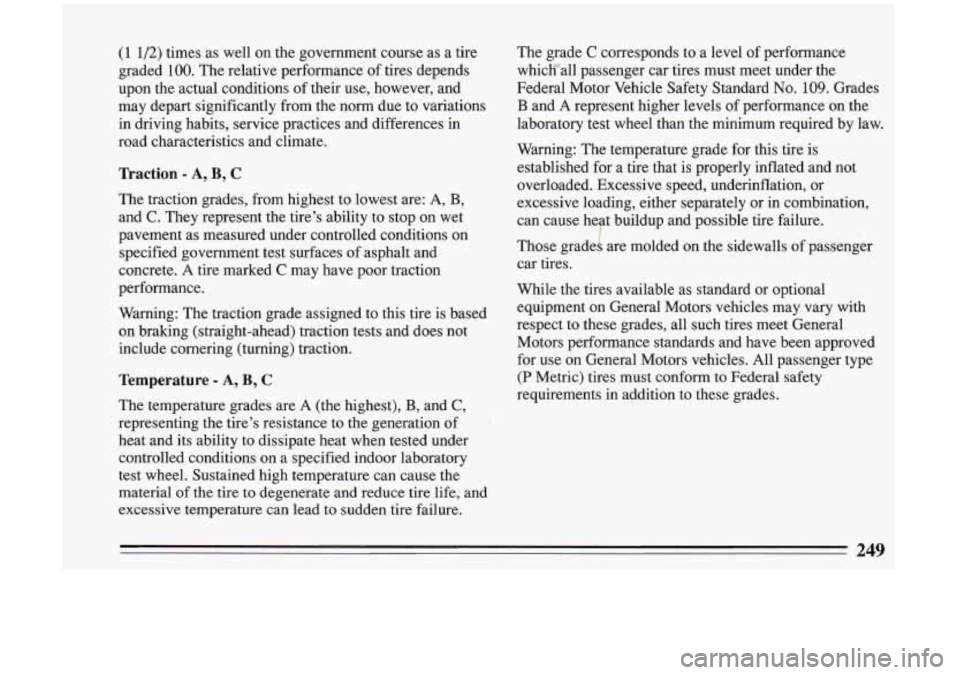
(1 1/2) times as well on the government course as a tire
graded
100. The relative performance of tires depends
upon the actual conditions of their use, however, and
may depart significantly from the norm due to variations
in driving habits, service practices and differences in
road characteristics and climate.
Traction - A, B, C
The traction grades, from highest to lowest are: A, B,
and C. They represent the tire’s ability to stop on wet
pavement as measured under controlled conditions on
specified government test surfaces of asphalt and
concrete. A tire marked
C may have poor traction
performance.
Warning: The traction grade assigned to this tire is based
on braking (straight-ahead) traction tests and does not
include cornering (turning) traction.
Temperature - A, B, C
The temperature grades are A (the highest), B, and C,
representing the tire’s resistance to the generation of
heat and its ability to dissipate heat when tested under
controlled conditions on a specified indoor laboratory
test wheel. Sustained high temperature can cause the
material of the tire
to degenerate and reduce tire life, and
excessive temperature can lead to sudden tire failure. The
grade
C corresponds to a level of performance
whicrall passenger car tires must meet under the
Federal Motor Vehicle Safety Standard
No. 109. Grades
B and A represent higher levels of performance on the
laboratory test wheel than the minimum required by law.
Warning: The temperature grade for this tire is
established for a tire that is properly inflated and not
overloaded. Excessive speed, underinflation, or
I
excessive loading, either separately or in combination, !
can cause heat buildup and possible tire failure.
Those grade
b are molded on the sidewalls of passenger
car tires.
While the tires available as standard or optional
equipment on General Motors vehicles may vary with
respect to these grades, all such tires meet General
Motors performance standards and have been approved
for use
on General Motors vehicles. All passenger type
(P Metric) tires must conform to Federal safety
requirements in addition to these grades.
249
Page 252 of 324
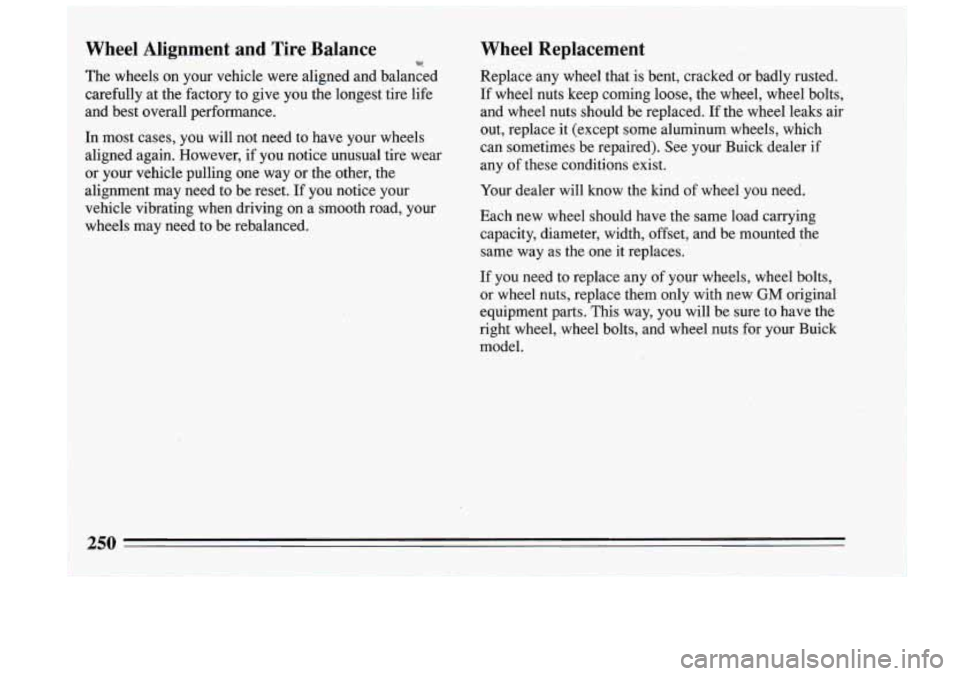
Wheel Alignment and Tire Balance w.
The wheels on your vehicle were aligned and balanced
carefully at the factory to give you the longest tire life
and best overall performance.
In most cases, you will not need to have your wheels
aligned again. However, if you notice unusual tire wear or your vehicle pulling one way or the other, the
alignment may need to be reset. If you notice your
vehicle vibrating when driving on a smooth road, your
wheels may need to be rebalanced.
Wheel Replacement
Replace any wheel that is bent, cracked or badly rusted.
If wheel nuts keep coming loose, the wheel, wheel bolts,
and wheel nuts should be replaced. If the wheel leaks air
out, replace it (except some aluminum wheels, which
can sometimes be repaired). See your Buick dealer if
any of these conditions exist.
Your dealer will know the kind of wheel you need.
Eachnew wheel should have the same load carrying
capacity, diameter, width, offset, and be mounted the
same way as the one it replaces.
If you need to replace any of your wheels, wheel bolts,
or wheel nuts, replace them only with new
GM original
equipment parts. This way, you will be sure to have the
right wheel, .wheel bolts, and wheel nuts for your Buick
model.
'1250
Page 253 of 324
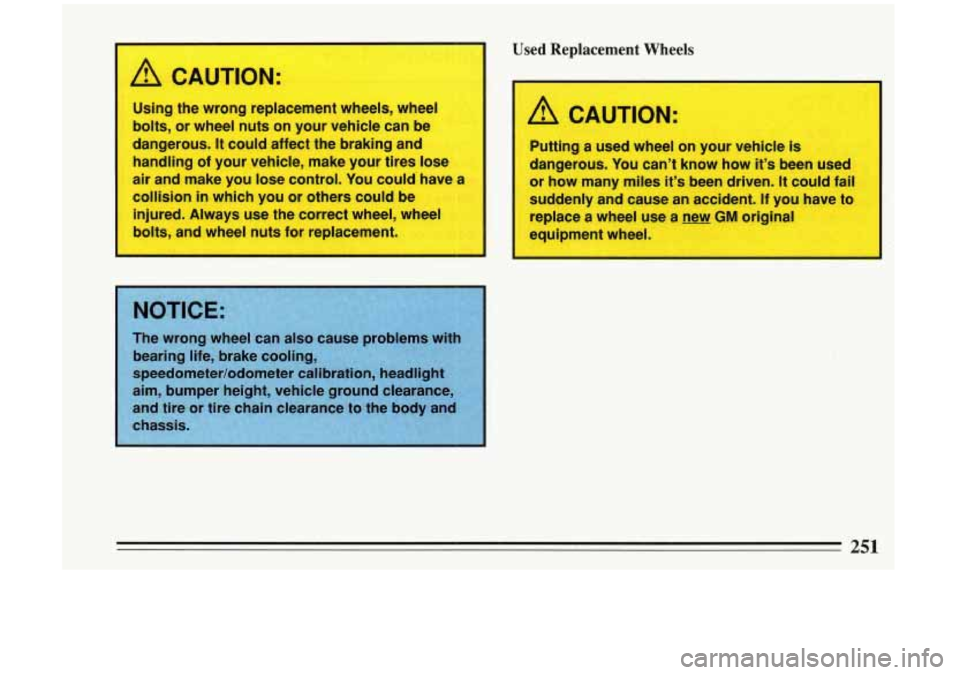
I
A CAUTION:
Using the wrong replacement wheels, wheel
bolts, or wheel nuts on your vehicle can be
dangerous.
It could affect the braking and
handling of your vehicle, make your tires lose
air and make you lose control. You could’ have a
collision
in which you or others could be
injured. Always use the correct wheel, wheel
bolts, and wheel nuts for replacement. I
Used Keplacement Wheels
I
A CAUTION:
Putting a used eel on your vehicle is
dangerous. You can’t know how
it’s been used
or how many miles it’s been driven.
It could fail
suddenly and cause an accident. If you have to
replace a wheel use a new
GM original
equipment wheel.
251
-
Page 254 of 324
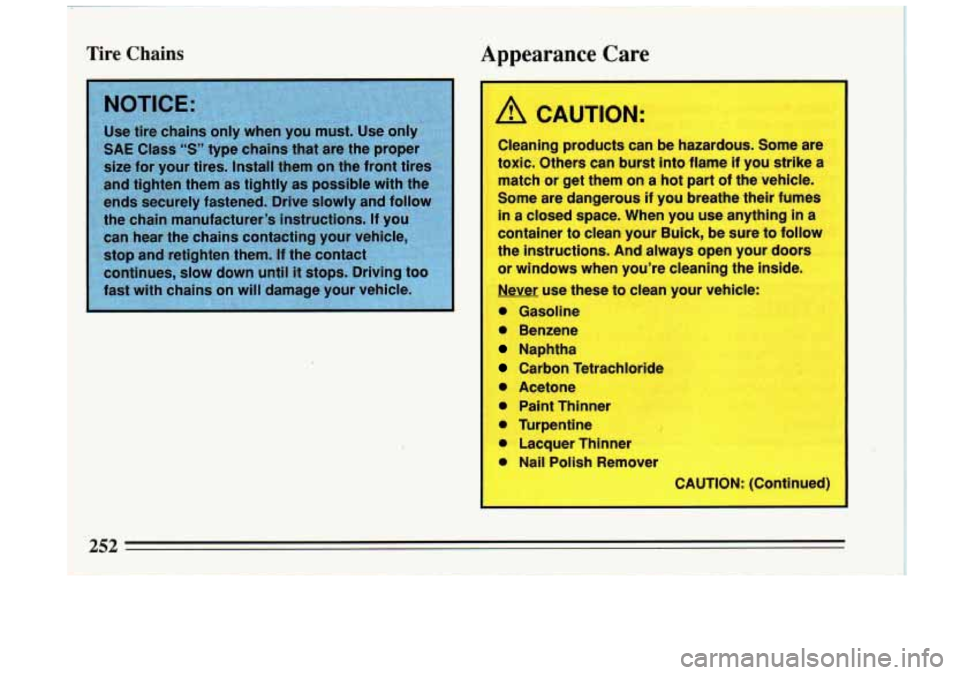
Tire Chains Appearance Care
A CAUTION:
Cleaning products can be hazardous. Some are
toxic. Others can burst into flame if you strike a
match or get them
on a hot part of the vehicle.
Some are dangerous
if you breathe their fumes
in a closed space. When you use anything in a
container to clean your Buick, be sure to follow
the instructions. And always open your doors
or windows when you’re cleaning
the inside.
Never use these to clean your vehicle:
0 Gasoline
0 Benzene
Naphtha
Carbon Tetrachlorid
0 Acetone
0 Paint Thinner
0 Turpentine
0 Lacquer Thinner
0 Nail Polish Remover
Page 255 of 324
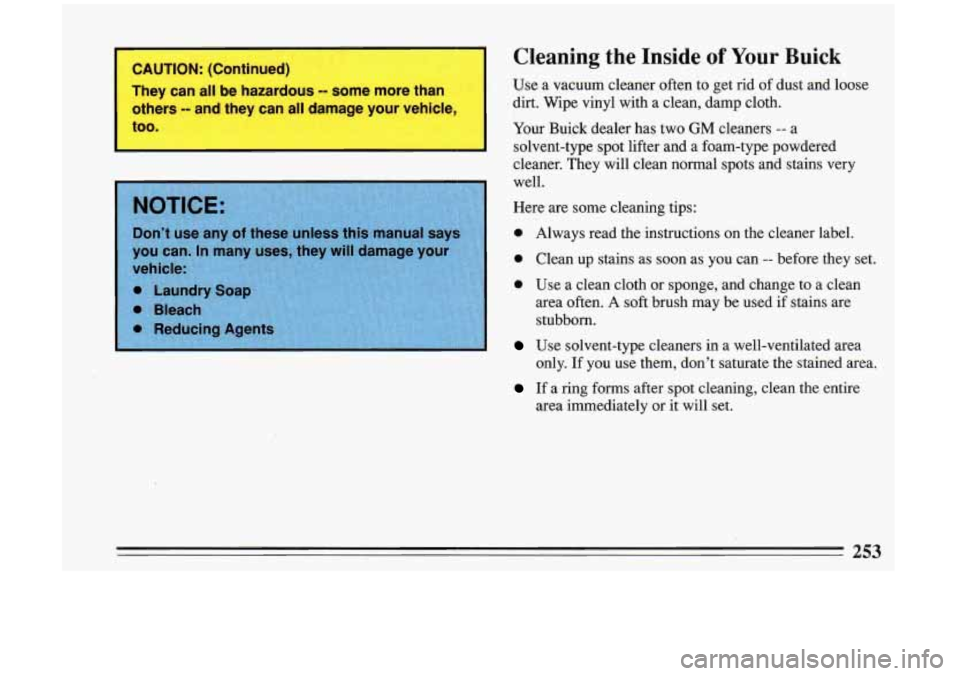
Cleaning the Inside of Your Buick
Use a vacuum cleaner often to get rid of dust and loose
dirt. Wipe vinyl with a clean, damp cloth.
Your Buick dealer has two
GM cleaners -- a
solvent-type spot lifter and a foam-type powdered
cleaner. They will clean normal spots and stains very
well.
Here are some cleaning tips:
0 Always read the instructions on the cleaner label.
0 Clean up stains as soon as you can -- before they set.
0 Use a clean cloth or sponge, and change to a clean
area often. A soft brush may be used if
stains are
stubborn.
Use solvent-type cleaners in a well-ventilated area
only. If you use them, don’t saturate the stained area.
If a ring forms after spot cleaning, clean the entire
area immediately or it will set.
Page 256 of 324
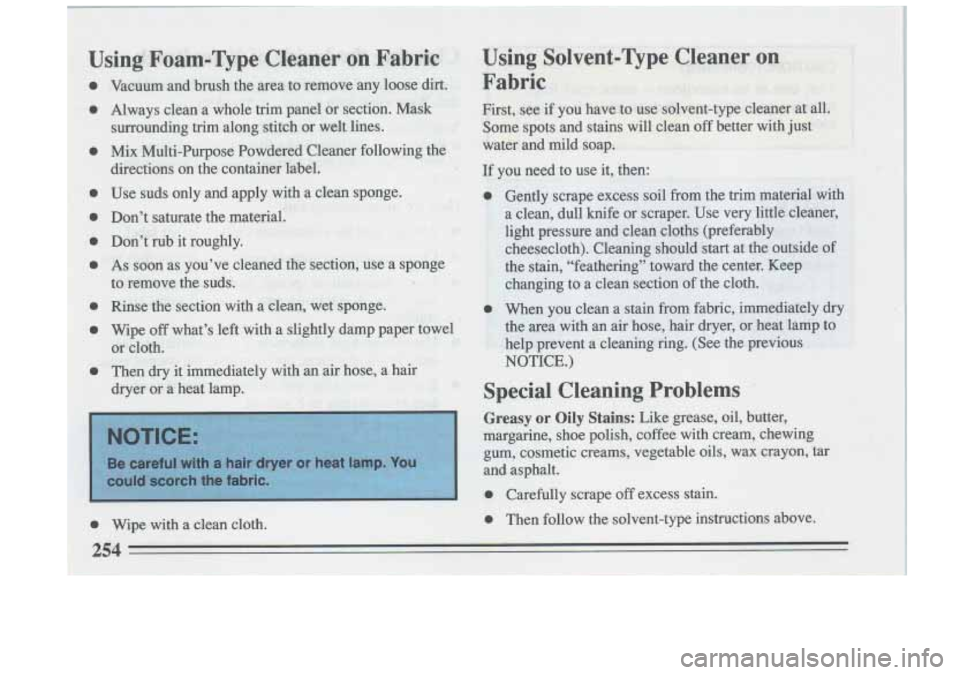
0 Wipe with a clean cloth.
Page 257 of 324
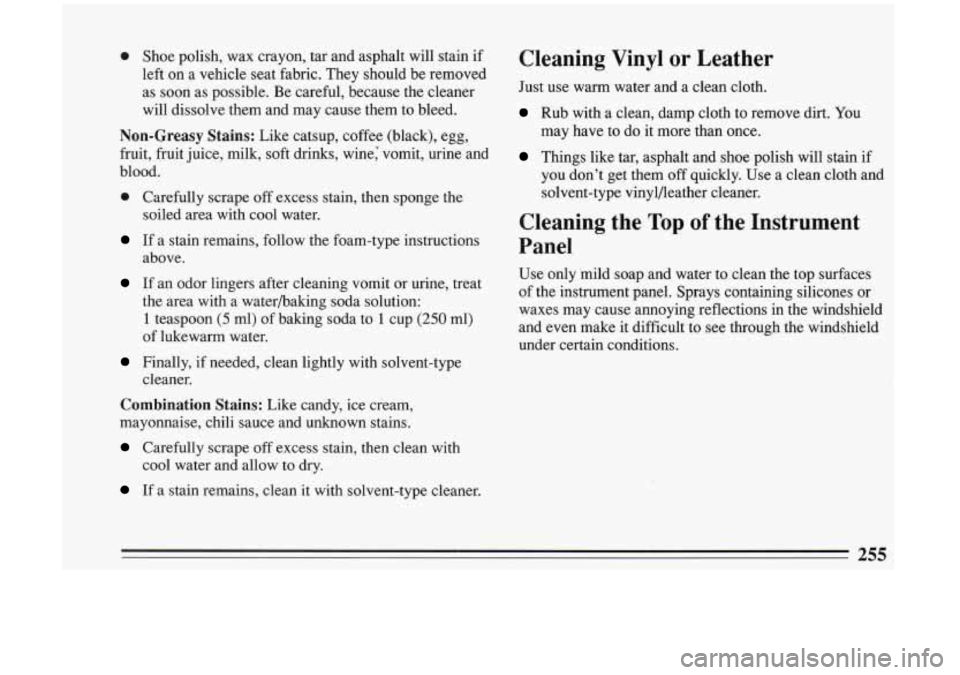
0 Shoe polish, wax crayon, tar and asphalt will stain if
left on a vehicle seat fabric. They should be removed
as
soon as possible. Be careful, because the cleaner
will dissolve them and may cause them to bleed.
Non-Greasy Stains: Like catsup, coffee (black), egg,
fruit, fruit juice, milk, soft drinks, wine: vomit, urine and
blood.
0. Carefully scrape off excess stain, then sponge the
If a stain remains, follow the foam-type instructions
If an odor lingers after cleaning vomit or urine, treat
soiled area with cool water.
above.
the area with a waterbaking soda solution:
1 teaspoon (5 ml) of baking soda to 1 cup (250 ml)
of lukewarm water.
Finally, if needed, clean lightly with solvent-type
Combination Stains: Like candy, ice cream,
mayonnaise, chili sauce and unknown stains.
Carefully scrape off excess stain, then clean with
If a stain remains, clean it with solvent-type cleaner.
cleaner.
cool water and allow to dry.
Cleaning Vinyl or Leather
Just use warm water and a clean cloth.
Rub with a clean, damp cloth to remove dirt.
You
Things like tar, asphalt and shoe polish will stain if may have to do it more than once.
you don't get 'them
off quickly. Use a clean cloth and
solvent-type vinylfieather cleaner.
Cleaning the Top of the Instrument
Panel
Use only 'mild soap and water to clean the top surfaces
of the instrument panel. Sprays containing silicones
or
waxes may cause annoying reflections in the windshield
and even make it difficult to see through the windshield
under certain conditions.
255
Page 258 of 324
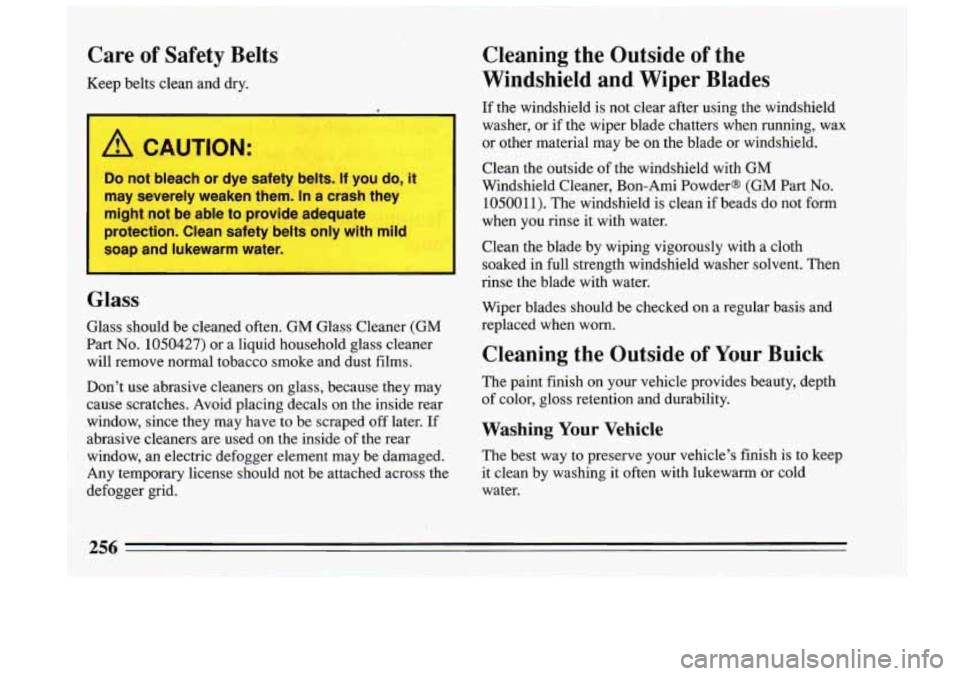
Care of Safety Belts
Keep belts clean and dry.
A CAUTION:
Do not bleach or dye safety belts. If you do, it
may severely weaken them. In a crash they
might not be able to provide adequate
protection. Clean safety belts only with mild
soap and lukewarm water.
Glass
Glass should be cleaned often. GM Glass Cleaner (GM
Part
No. 1050427) or a liquid household glass cleaner
will remove normal tobacco smoke and dust films.
Don’t use abrasive cleaners on glass, because they may
cause scratches. Avoid placing decals on the inside rear
window, since they may have to be scraped
off later. If
abrasive cleaners are used on the inside of the rear
window, an electric defogger element may be damaged.
Any temporary license should not be attached across the
defogger grid.
I
Cleaning the Outside of the
Windshield and Wiper Blades
If the windshield is not clear after using the windshield
washer, or if the wiper blade chatters when running, wax
or other material may be on the blade or windshield.
Clean the outside
of the windshield with GM
Windshield Cleaner, Bon-Ami Powders (GM Part
No.
105001 1). The windshield is clean if beads do not form
when you rinse it with water.
Clean the blade by wiping vigorously with a cloth
soaked in full strength windshield washer solvent. Then
rinse the blade with water.
Wiper blades should be checked on a regular basis and
replaced when worn.
Cleaning the Outside of Your Buick
The paint finish on your vehicle provides beauty, depth
of color, gloss retention and durability.
Washing Your Vehicle
The best way to preserve your vehicle’s finish is to keep
it clean by washing it often with lukewarm or cold
water.
Page 259 of 324
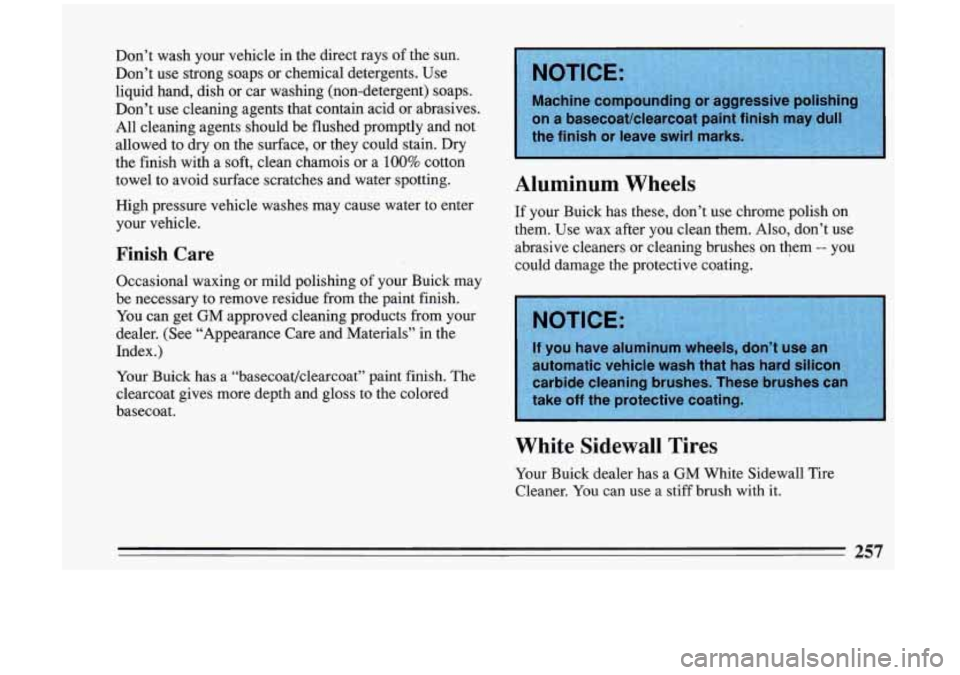
Aluminum Wheels
If your Buick has these, don’t use chrome polish on
them. Use wax after you clean them. Also, don’t use
abrasive cleaners or cleaning brushes
on them -- you
could damage the protective coating.
White Sidewall Tires
Your Buick dealer has a GM White Sidewall Tire
Cleaner. You can
use a stiff brush with it.
257
Page 260 of 324
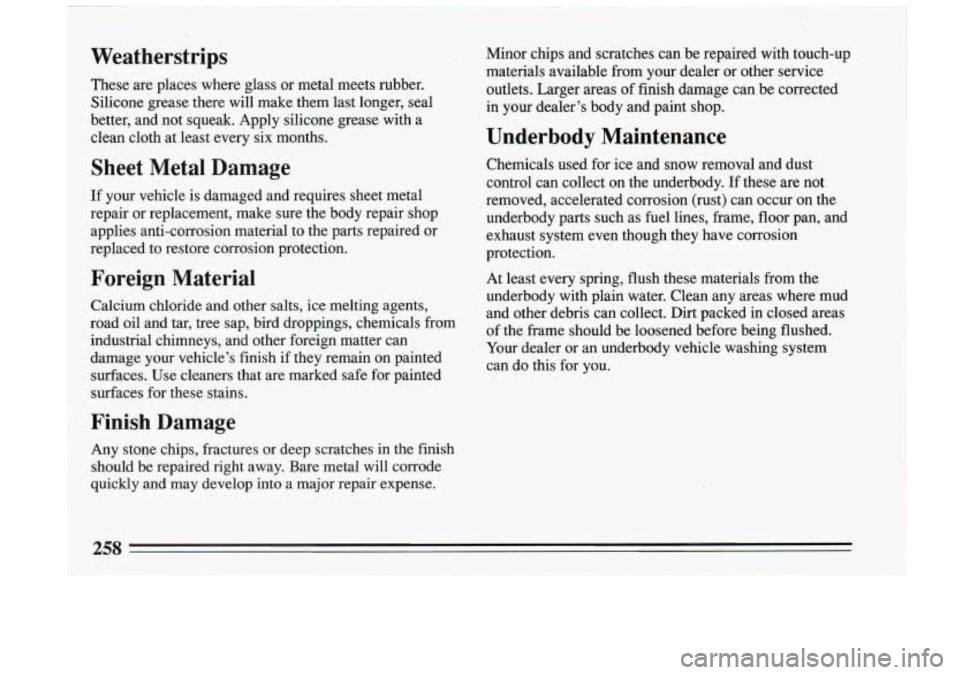
Weatherstrips
-These are places where glass or metal meets rubber.
Silicone grease there will make them last longer, seal
better, and not squeak. Apply silicone grease with a
clean cloth at least every six months.
Sheet Metal Damage
.If your vehicle is damaged and requires sheet metal
.repair or replacement, make sure the body repair shop
: applies anti-corrosion material to the parts repaired or
replaced to restore corrosion protection.
-Foreign Material
Calcium chloride and other salts, ice melting agents,
road oil and tar, tree sap, bird droppings, chemicals from industrial chimneys, and other foreign matter can
damage your vehicle’s finish if they remain on painted
surfaces. Use cleaners that are marked safe for painted
surfaces for these stains.
Finish Damage
Any stone chips, fractures or deep scratches in the finish
should be repaired right away. Bare metal will corrode
quickly and may develop into a major repair expense. Minor chips and scratches can be repaired with touch-up
materials available fi-om your dealer
or other service
outlets. Larger areas of finish damage can be corrected
in your dealer’s body and paint shop.
Underbody Maintenance
Chemicals used for ice and snow removal and dust
control can collect
on the underbody. If these are not
removed, accelerated corrosion (rust) can occur on the Underbody parts such as fuel lines, frame, floor pan, and
exhaust system even though
they have corrosion
protection.
At least every spring, flush these materials from the
underbody with plain water. Clean any areas where mud
and other debris can collect. Dirt packed in closed areas
of the frame should be loosened before being flushed.
Your dealer or an underbody vehicle washing system
can do this for you.